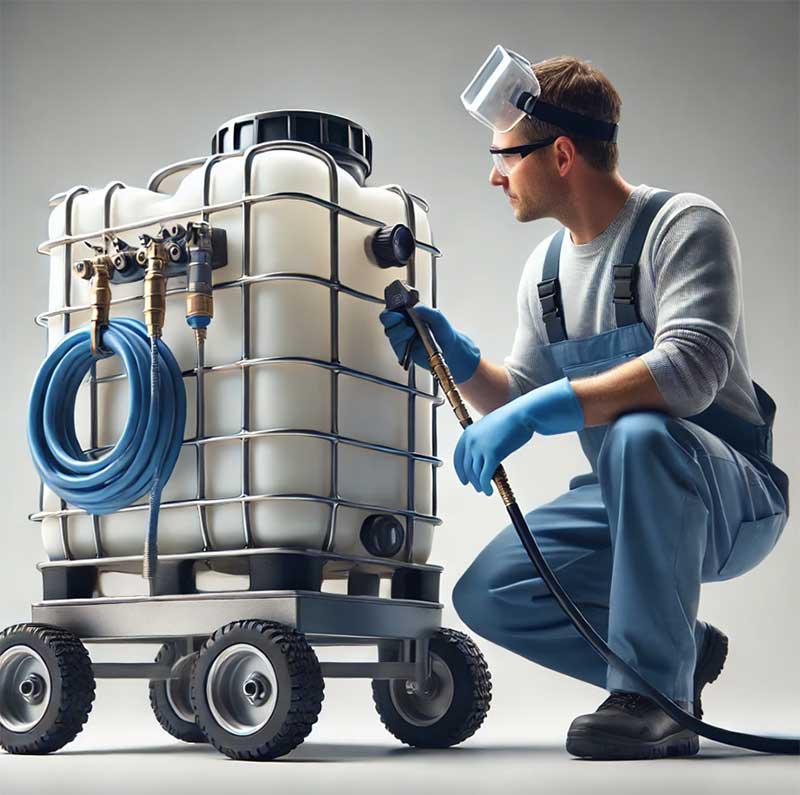Best Maintenance Practices for Tanks: Keep Your Equipment Performing at Its Best
Why Tank Maintenance Matters
Whether you're operating a soft wash system, a pressure washer, or chemical sprayers, proper tank maintenance is essential to keeping your equipment running efficiently and safely. Tanks used in the cleaning industry handle a variety of chemicals, including sodium hypochlorite, degreasers, and surfactants—all of which can degrade components over time if not properly managed.
Implementing routine maintenance not only extends the life of your equipment, but also helps prevent downtime, costly repairs, and potential safety hazards. In this guide, we’ll cover the best maintenance practices for tanks, including cleaning schedules, inspection tips, and recommended products to ensure peak performance for your business.

1. Inspect Tanks Regularly for Wear and Damage
The first step in effective tank maintenance is frequent visual inspections. Cracks, bulges, or discoloration can be early signs of stress or chemical breakdown
What to Look For:
- Stress fractures or hairline cracks
- Discoloration from chemical exposure
- Bulging or warping from overpressurization
- Corroded fittings or damaged valves
Inspect tanks before and after each use, especially when working with pressure washing chemicals or OSHA-approved cleaners, which can be corrosive over time
Tip: Use a flashlight to inspect the interior of opaque tanks, and record all signs of wear in a maintenance log
2. Clean Tanks After Every Use
Residual chemicals—especially those like sodium hypochlorite—can degrade tank materials if left sitting for extended periods. Cleaning tanks after each job helps prevent chemical buildup and cross-contamination between jobs.
Cleaning Tips:
- Rinse thoroughly with clean water
- Use an eco-friendly neutralizing agent after using strong chemicals
- For tanks storing oxidizing agents, use non-reactive cleaners to avoid dangerous reactions
Always wear appropriate PPE (gloves, goggles, respirator) during tank cleaning, and ensure proper ventilation when using any chemical cleaner.
Related Resource: Safe Handling Tips for Sodium Hypochlorite
3. Flush and Sanitize Hoses and Fittings
Cleaning the tank alone isn't enough—hoses, nozzles, and fittings connected to your tank also require regular attention. Contaminants or chemical residue can clog nozzles or corrode metal components, especially in high-pressure systems.
Maintenance Practices:
- Flush hoses with fresh water after each use
- Remove and soak nozzles in a non-corrosive cleaning solution
- Inspect gaskets and seals for cracks or hardening
- Sanitize components if switching between different types of chemicals
Use only cleaning solutions compatible with your tank and fittings, and replace any damaged parts immediately.
4. Use Chemical-Compatible Tanks
Not all tanks are created equal. Selecting a tank that’s rated for the chemicals you use ensures longer equipment life and fewer safety risks.
For Example:
- Use polyethylene tanks for storing sodium hypochlorite or bleach-based cleaners
- Select tanks with UV protection if exposed to sunlight
- Choose tanks with heavy-duty fittings and gaskets for industrial use
LNI Equipment offers a selection of chemical-resistant tanks designed for both soft wash and pressure washing applications.
View Our Selection of Chemical Tanks
5. Label and Store Tanks Properly
Proper labeling and storage prevent accidents and help you stay compliant with OSHA and EPA standards
Storage Guidelines:
- Store tanks in well-ventilated, shaded areas
- Clearly label each tank with the chemical name and hazard warnings
- Keep tanks off the ground on non-reactive pallets to prevent moisture accumulation
- Use color-coded lids or caps to quickly identify contents
Storing your tanks properly minimizes exposure to heat and UV light, which can cause chemical degradation or tank damage over time.
6. Schedule Preventative Maintenance Checks
Creating a routine maintenance schedule ensures that tank upkeep becomes a consistent part of your operations.
Maintenance Schedule Example:
- Daily:Quick inspection for leaks and external damage
- Weekly:Flush tanks and inspect valves, caps, and hoses
- Monthly:Deep clean tanks and check interior condition
- Quarterly: Replace worn fittings and update tank labels
Preventative maintenance reduces the likelihood of equipment failure and helps your business stay ahead of any operational disruptions.
Common Tank Maintenance Mistakes to Avoid
Avoid these frequent errors to protect your investment:
- Leaving chemicals in tanks for long periods
- Using incompatible cleaning solutions that degrade tank material
- Neglecting to flush hoses and nozzles after use
- Ignoring small leaks or signs of wear until they cause bigger issues
- Failing to replace old or cracked seals and gaskets
Being proactive in tank care keeps your system running reliably and safely.
Frequently Asked Questions (FAQs)
Q1: How often should I clean my chemical tanks? A: Clean tanks after every use to prevent chemical buildup and cross-contamination
Q2: What types of tanks are best for sodium hypochlorite? A: Use polyethylene tanks that are UV-resistant and chemical-compatible with oxidizing agents.
Q3: Can I use the same tank for different cleaning chemicals? A: It’s best to use dedicated tanks for each type of chemical, or thoroughly clean and neutralize the tank between uses.
Conclusion: Protect Your Equipment with Proper Tank Maintenance
Maintaining your tanks is a critical part of running a safe, efficient, and professional cleaning operation. From daily inspections to thorough cleanings, staying proactive helps you avoid breakdowns, protect your investment, and deliver consistently high-quality service.
Whether you're using tanks for pressure washing, soft washing, or chemical application, trust LNI Equipment for durable, industry-tested solutions.
Browse our full collection of tanks, fittings, and accessories to upgrade your cleaning system today
Explore Tanks at LNI Equipment.
